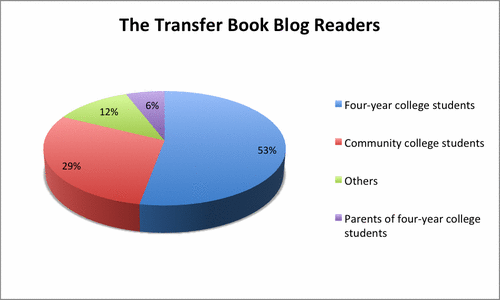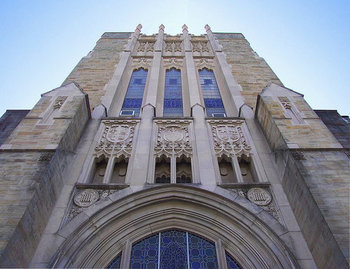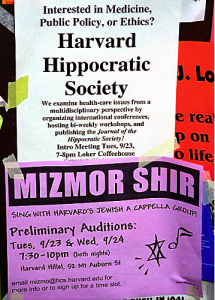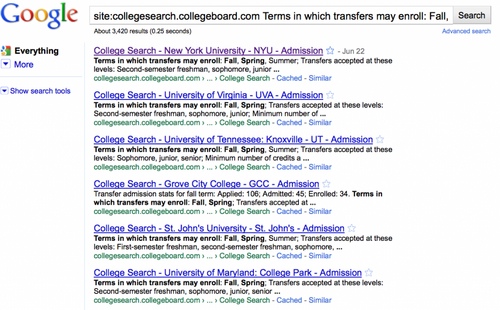
In this post, we analyze an essay example excerpted from College Admission Essays for Dummies by Geraldine Woods to complement the example for the University of Pennsylvania that we’ve previously critiqued. The essay we’ll analyze here leaves a lot of room for improvement, though it has some positive aspects. We’ll tell you what you can do to write a much better essay and give you advice on writing a winning piece. Lastly, we have no idea whether the application that this essay was a part of was successful or not, or even if this essay was actually written by a student applying to a school. If you want other examples, our book provides examples of actual successful transfer essays (and stats) for Stanford, UPenn, Columbia, Cornell, and other schools.
The essay here includes reasons for transferring to a specific four-year school, Northern State. Many colleges and universities now use the Common Application for transfer applications, requiring transfer applicants to write a Common Application essay describing the reasons for transferring and to also write several school-specific supplement essays. The prompt for this essay wasn’t included, but it was probably for a school-specific essay. We’ll critique the essay as is and explain parts that might fit into the Common Application essay or a school-specific essay. We’ll analyze the essay one paragraph at a time.
Paragraph 1:
No, I am not homesick. I have friends. The work is not overwhelming. Nor has it interfered with my involvement in extracurricular activities. My first semester has been a time of transition as it is for most college freshmen. Making decisions regarding course selection, seeking advice from advisors, and utilizing time efficiently have all been part of the process, accomplished at a distance from the familiar support structures and cues of both home and high school. As a result, I have developed a greater sense of myself and my abilities, both academic and social. The experience has been satisfying. However, with all due introspection and now retrospection, I feel a change is necessary.
This opening is fairly weak because it is very general. I learned very little about this applicant from this paragraph, which could be entirely omitted to reduce the number of unnecessary words. Admission officers have many applications to read; there’s no need to burden them with excessive words. Some of the best Common Application transfer essays I’ve read started with a brief “a slice of life” anecdote, a short narrative that captures an episode in one’s life. If you decide to feature an anecdote in your introduction, create a vivid image (or movie) of a piece of your life in the reader’s mind. You would then have a hook. Other than including a short transition, avoid dragging this story into the next paragraph. Don’t make this episode the sole content of your essay. For school-specific essays, which often have a tight word limit, writing an anecdote might not be the best use of the limited space. Instead, consider writing one or two introductory sentences and then diving right into your specific reasons for wanting to transfer.
Paragraph 2:
Sociologist Lev Vygotsky believed that peers play a major role in an individual’s development and learning. The students and friends with whom I grew up were extraordinarily bright, competitive, and creative. In high school, discussions and opinions on almost any subject were spontaneous and interesting. At Central State, the small class size and the seminar formats have presented a great setting in which to learn. The highly motivated professors, who encourage participation, have been the highlight of my experience thus far. However, the level of student interaction has not been gratifying. Conversations concerning classroom topics and related materials have been limited. I have not been sufficiently challenged or stimulated by my peers.
This paragraph has an interesting topic sentence. Also, the applicant writes positively about her current school, citing, for example, its small class size and the seminar formats. Avoid sounding overly negative about your current school because you don’t want to badmouth any school. Despite its positive aspects, this paragraph lacks concrete details. Why is it that “the level of student interaction has not been gratifying”? What did the writer mean in stating, “Conversations concerning classroom topics and related materials have been limited”? Adhering to the word limit, make sure to reserve space for specific details that will help the reader understand exactly why you want to transfer.
If you’re writing a general Common Application transfer essay that is not about a specific school, you should include this type of information so that much of your essay will discuss why your current school isn’t your best fit (but don’t be too negative!). On the other hand, a school-specific “why transfer” essay needs to focus on the aspects of that particular school that align with your needs or the type of college experience that you seek. See more information on our blog post about writing the Common Application main transfer essay versus the school-specific supplemental essay.
Paragraph 3:
During my first semester, I have come to realize the influence a community has on my learning and growth. At Central State, the campus is active from around eleven in the morning until three in the afternoon, Monday through Friday. One Saturday in October, while walking to the dining hall, I realized that I was one of five people on campus. With the majority of undergraduates living in on-campus dorms, the campus of Northern State fosters a unique intimacy. The campus is lively throughout the day. Such activity creates a comfortable environment that promotes interaction and the formation of strong bonds between members of the community. Having experienced a year of college and dorm life, I am more aware of what is best for me. As a transfer student, I would appreciate this style of living even more.
The type of information in this paragraph is well-suited for a school-specific transfer essay. The writer has now moved from focusing on classes to discussing campus life. The statement, “One Saturday in October, while walking to the dining hall, I realized that I was one of five people on campus” provides clear imagery of a negative aspect of the applicant’s current school in terms of the applicant’s needs or desires. Brief examples should be included to show how Northern State “fosters a unique intimacy” and how it is “lively throughout the day.” To conclude this paragraph, the applicant writes, “As a transfer student, I would appreciate this style of living even more.” I wonder what she plans to do to take advantage of this style of living so that she can be more appreciative of it.
Paragraph 4:
Based on conversations with current students, it is my understanding that members of the Northern State community make it a unique place to live and learn. Many renowned professors choose to teach at the undergraduate level. Having the chance to interact with an instructor such as Avery Marks, whose passion and mastery of botany are unrivaled, would be quite an experience. The most defining aspect of Northern State’s faculty, however, is the manner in which they approach their role in influencing a student’s life. Professors, instructors, and advisors guide the student so that he/she can make independent decisions.
By the end of the paragraph, we still don’t know how “members of the Northern State community make it a unique place to live and learn,” but as you’ll see, she gives a clear example in the next paragraph. Here, the applicant includes interesting, specific examples to show that she knows about the school and has compelling reasons to want to transfer there. Mentioning a specific professor that you’re interested in would show that you’ve researched the school. If you plan to major in biology and you’re especially interested in plants, highlighting a professor who specializes in botany, as in this paragraph, would be appropriate, but avoid empty name-dropping. Your interest in, say biology or botany, should also be apparent in other parts of your application. The last sentence regarding student guidance does not seem to be substantiated anywhere in the paragraph or essay.
Paragraph 5:
Furthermore, the structure and aspects of Northern State’s residential colleges foster the formation of relationships. For the remainder of my undergraduate years I want to return “home” to a very close group of friends for nightly dinners and conversations concerning daily activities. The strong bonds that are formed within a diverse group of people who make up these individual communities create an optimal atmosphere in which to grow, socially and intellectually.
This paragraph, which emphasizes a unique aspect of Northern State, provides an example of information to include in a school-specific transfer essay.
Concluding paragraph:
All aspects of Northern State seem to enhance learning. Guidance from faculty members and challenges from peers within Northern’s close-knit community create a setting in which I can pursue current interests and discover new one while simultaneously discovering my future direction. This is the purpose of the undergraduate experience.
The best part of this conclusion is its brevity. I’m not sure what “this” refers to in the last sentence; many writing guides suggest that you place a noun after “this” to avoid ambiguity. Though every essay does not need to end with a “bang,” conclusions should be at least interesting. One strategy for writing a good conclusion is to tie it to the introduction, a strategy that could not be used in this essay due to its weak, general introduction. We talk about this tie-back strategy in our post about writing an introduction and conclusion to your transfer essay.
Concluding words: Each transfer application is unique, and therefore, we cannot provide an exhaustive list of details and information that should be included. Use this analysis as a guideline for writing your Common Application and school supplemental essays and try to critique your own essays in the manner we’ve done here.
(Photo: xelcise)









